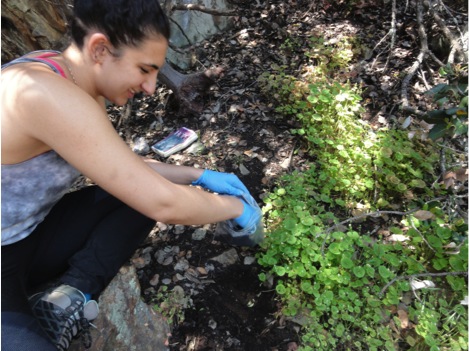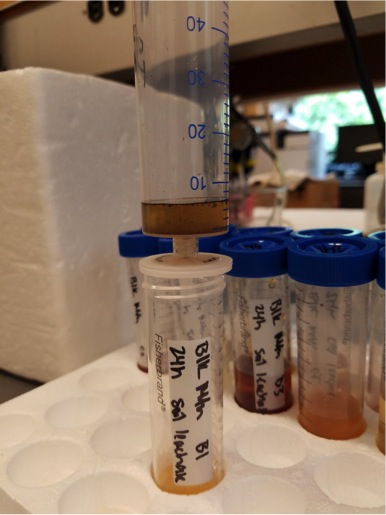Wooster, OH – If you’ve been following our summer research adventures, you know that Amineh AlBashaireh (’18) has been hard at work studying the compositions of soils around abandoned mines in Black Mountain Open Space Park in San Diego, CA. She wrote the following abstract for the Geological Society of America Annual Meeting in Denver, Colorado this September.

Amineh AlBashaireh (’18) collecting a soil sample surrounded by miner’s lettuce outside of Koala Mine in Black Mountain Open Space Park, San Diego, CA.
Evaluation of Arsenic Extent and Mobilization in Soil and Vegetation surrounding abandoned, ultra-enriched Arsenic Mines in Black Mountain Open Space Park, San Diego, California to GSA
ALBASHAIREH, Amineh B.1, JOHNSTON, Elizabeth2, O’SHEA, Bethany2 and POLLOCK, Meagen1, (1)Department of Geology, The College of Wooster, 944 College Mall, Wooster, OH 44691, (2)Environmental and Ocean Sciences, University of San Diego, 5998 Alcala Park, San Diego, CA 92110
Black Mountain Open Space Park in San Diego, CA is part of the Santiago Peak Volcanic Formation, a heterogeneous meta-volcanic unit that is locally ultra-enriched in arsenic (As). Small scale, artisanal-type As mining occurred during the early 1920s. Mines were abandoned with little documentation and no obvious remediation efforts. Initial field study by portable XRF yielded As concentrations up to 480,000 ppm in abandoned mines and rock outcrops throughout the park. This study is a first step towards understanding As fractionation in soils surrounding the mines. Twelve samples from the surface 5 cm of soil were collected in a ~48 m2 grid between two of the abandoned mines to determine how As concentration varies spatially, the degree of As mobilization during rain events, and how plants sequester As and affect soil As. Soils were pressed into pellets for analysis via WDXRF, and LOI was used to distinguish between organic and mineral-rich soils. To simulate transport by precipitation, 1:5 DI water leaches were performed on soils for 1 h, 24 h, and 7 day periods. Vegetation (miner’s lettuce, lemonade berry, and fern) was collected from the grid and will be analyzed by SEM-EDS for the extent of As throughout plant roots and bodies. While the crustal average for As is 1.5 ppm, soil concentration of As varies from hundreds of ppm to tens of thousands of ppm between the two mines. Consistent with hypotheses, the two greatest As concentrations occurred in rocky soils, possibly due to the presence of waste rock in the naturally occurring San Miguel-Exchequer rocky silt loam. Vegetation in the area appears healthy, but is not growing consistently across the grid, so SEM data will be compared with soil organic matter content and As concentration. San Diego’s semi-arid climate causes low precipitation and increased rates of soil erosion, making aeolian dispersion a likely mode of As transport. Consequently, there’s a potential health risk for those traveling off trail to visit the mines, hiking along the trails, and living in the canyon outlet. This is the first soil-plant arsenic study in a broader project aimed at understanding potential impact to public health. Additionally, this project has implications for the geologic occurrence of extreme As concentrations in igneous rocks from island arc settings.

Filtration step of 24h deionized water leach on <1.0 mm Black Mountain soil.
After the prescribed leach time, samples are centrifuged and filtered using a syringe fitted with a nylon filter to separate leachate (amber to red liquid above) from soil.



Good work, Amineh!
Nice Job Amineh – I look forward to the poster.
This is really interesting, and very appropriate in our world of unwanted mine effluents!
A couple of questions/suggestions: First, since that mine appears to have been a gold deposit (from some of the earlier posts about the area) arsenopyrite is a more common association with gold ores, in general. But, if there really wasn’t any gold associated with this deposit (a sales ploy often employed by people trying to sell mineral rights), and it was targeted just for the arsenic, realgar/orpiment might be the more logical As-bearing minerals. Au (and, therefore, arsenopyrite) tends to occur deeper within hydrothermal systems, while pure As-sulfides tend to be more associated with very-near-surface volcanic emanations (fumaroles). To know As mobility in the surface/soil environment, you should try to determine the As mineralogy, if possible, because the 3 common As-bearing minerals in the volcanogenic environment will react differently to groundwater conditions.
Second, did the leach experiments use groundwater-mimicking pH levels, or just de-ionized water from the lab? The pH level (along with other chemical constituents) of the groundwater will control As mobility greatly, as will, perhaps, biologic activity and other organic constituents in the soils.
480,000 ppm–Wow–that’s 48%!! You must have directly fluoresced an As mineral!